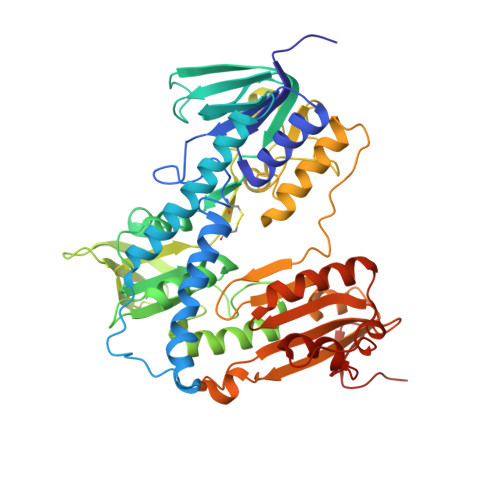Pyrrolopyrimidine vs Imidazole-Phenyl-Thiazole Scaffolds in Nonpeptidic Dimerization Inhibitors of Leishmania infantum Trypanothione Reductase.
Revuelto, A., Ruiz-Santaquiteria, M., de Lucio, H., Gamo, A., Carriles, A.A., Gutierrez, K.J., Sanchez-Murcia, P.A., Hermoso, J.A., Gago, F., Camarasa, M.J., Jimenez-Ruiz, A., Velazquez, S.(2019) ACS Infect Dis 5: 873-891
- PubMed: 30983322
- DOI: https://doi.org/10.1021/acsinfecdis.8b00355
- Primary Citation of Related Structures:
6I7N - PubMed Abstract:
Disruption of protein-protein interactions of essential oligomeric enzymes by small molecules represents a significant challenge. We recently reported some linear and cyclic peptides derived from an α-helical region present in the homodimeric interface of Leishmania infantum trypanothione reductase ( Li-TryR) that showed potent effects on both dimerization and redox activity of this essential enzyme. Here, we describe our first steps toward the design of nonpeptidic small-molecule Li-TryR dimerization disruptors using a proteomimetic approach. The pyrrolopyrimidine and the 5-6-5 imidazole-phenyl-thiazole α-helix-mimetic scaffolds were suitably decorated with substituents that could mimic three key residues (K, Q, and I) of the linear peptide prototype (PKIIQSVGIS-Nle-K-Nle). Extensive optimization of previously described synthetic methodologies was required. A library of 15 compounds bearing different hydrophobic alkyl and aromatic substituents was synthesized. The imidazole-phenyl-thiazole-based analogues outperformed the pyrrolopyrimidine-based derivatives in both inhibiting the enzyme and killing extracellular and intracellular parasites in cell culture. The most active imidazole-phenyl-thiazole compounds 3e and 3f inhibit Li-TryR and prevent growth of the parasites at low micromolar concentrations similar to those required by the peptide prototype. The intrinsic fluorescence of these compounds inside the parasites visually demonstrates their good permeability in comparison with previous peptide-based Li-TryR dimerization disruptors.
Organizational Affiliation:
Instituto de Química Médica (IQM-CSIC) , Madrid E-28006 , Spain.


















